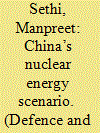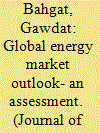|
|
|
Sort Order |
|
|
|
Items / Page
|
|
|
|
|
|
|
| Srl | Item |
| 1 |
ID:
125832


|
|
|
|
|
| Publication |
2013.
|
| Summary/Abstract |
This paper examines economic analyses of the "Options for Energy and the Environment" proposed by the Japanese government. The main focuses of the analyses are the power generation mix in 2030, and particularly electricity supply shares of nuclear power. The options proposed by the government assume drastic energy efficiency improvements, increase in renewable energy, and deep CO2 emission reductions. Considerable energy savings are assumed by the government even in the baseline scenario, and these are inconsistent with historical growth trends for GDP and power demand. We modify the energy savings baseline scenario for consistency with the historical trends and historical electricity savings after the nuclear power accident. In order to provide a wider array of options, particularly those with fewer negative impacts on GDP, this paper proposes alternative options under a revised baseline. In the alternative options, we assume lower shares of renewable energy in electricity supply and lower carbon price. The economic impacts for the alternative options are much smaller than those assumed by the government. The economic analyses provided in this paper will help future policy making for energy and environment in Japan.
|
|
|
|
|
|
|
|
|
|
|
|
|
|
|
|
| 2 |
ID:
135524


|
|
|
|
|
| Summary/Abstract |
China’s rapid socio-economic transformation, which is today being studies as a model of unprecedented economic growth, was enabled by a phenomenal surge in electricity production and consumption. from a total electricity production base of only 282 billion kilowatt hours (kWh) in 1979, china is today the largest electricity producer at 4604 billion kWh (compared to India’s 835 billion kWh).
|
|
|
|
|
|
|
|
|
|
|
|
|
|
|
|
| 3 |
ID:
149863


|
|
|
|
|
| Summary/Abstract |
While the shale revolution was largely a US’ affair, it affects the global energy system. In this paper, we look at the effects of this spectacular increase in natural gas, and oil, extraction capacity can have on the mix of primary energy sources, on energy prices, and through that on internal political stability of rentier states. We use two exploratory simulation models to investigate the consequences of the combination of both complexity and uncertainty in relation to the global energy system and state stability. Our simulations show that shale developments could be seen as part of a long term hog-cycle, with a short term drop in oil prices if unconventional supply substitutes demand for oil. These lower oil prices may lead to instability in rentier states neighbouring the EU, especially when dependence on oil and gas income is high, youth bulges are present, or buffers like sovereign wealth funds are too limited to bridge the negative economic effects of temporary low oil prices.
|
|
|
|
|
|
|
|
|
|
|
|
|
|
|
|
| 4 |
ID:
116430


|
|
|
| 5 |
ID:
181778


|
|
|
|
|
| Summary/Abstract |
Many countries, states, and territories have set short and long term targets to increase the share of renewable sources for electricity generation as part of their respective energy policies. Increased reliance on renewables can occur from several sources (e.g., biomass, solar, hydro, wind). Similarly, when increasing renewables, a decreased reliance on one or more non-renewable (e.g., coal, gas, oil, nuclear) sources must occur. However, each region is different with respect to its present profile and capabilities to generate electricity. Complicating this is that demand can differ across individuals, states and territories. By using a discrete choice experiment and latent class hybrid choice model (LCHCM), we estimate individual willingness to pay (WTP) values among four renewable and four non-renewable energy sources for residents across Australia’s states and territories. The model identifies two latent segments in relation to WTP, which can be described using differences in pro-environmental attitudes and socio-demographics. The findings reveal that preferences in terms of energy mix composition for electricity generation are heterogeneous across Australia states and individuals. WTP is found to be higher for biomass, whilst those who are younger, males and those holding pro-environmental attitudes are also supportive of hydro and solar over gas and nuclear sources.
|
|
|
|
|
|
|
|
|
|
|
|
|
|
|
|
| 6 |
ID:
104973


|
|
|
|
|
| Publication |
2011.
|
| Summary/Abstract |
Managing urban energy system is vital for energy conservation and CO2 reduction. Integrating energy input-output model with carbon emission pinch analysis, we propose a framework for managing urban energy system. This framework could analyze current energy demands and CO2 emissions, predict their future possibilities and optimize energy mix of key sectors under CO2 emission constraints. Key sectors are identified by the energy input-output table from both direct and accumulative perspectives. Moreover, taking Suzhou, a typical manufacturing center and export-oriented city in China, as a case example, energy metabolism of Suzhou in 2020 is predicted using energy input-output model. And three sectors named Coking, Smelting and pressing of metals and Production and supply of electric power are identified to have big effects on CO2 emissions. Subsequently, energy mix of three identified key sectors is optimized under CO2 emission constraints by the carbon emission pinch analysis. According to the results, clean energy sources will occupy a great position in Suzhou's future energy demands. And the reuse of wastes as energy sources should be limited to achieve CO2 mitigation targets. Finally, policy implications of results and future work are discussed.
|
|
|
|
|
|
|
|
|
|
|
|
|
|
|
|
| 7 |
ID:
177340


|
|
|
|
|
| Summary/Abstract |
Nigeria has made pledges at various international fora to mainstream renewable energy in its energy mix. In keeping with these pledges, the country's domain for alternative clean energy development is filled with multitudinous policy documents. This paper undertakes a systematic appraisal of the subsisting opportunities, pitfalls and dilemmas surrounding Nigeria's quest for alternative clean energy development. The data for this paper are generated from key informant interviews as well as formal policy documents and scholarly archival materials. The paper finds a huge gap between setting national energy transition targets and realizing same. It further finds that Nigeria is yet to begin its journey of energy transition from fossil fuels to renewable energy in real terms despite ambitious targets and projections. It links it to structural gaps, policy discordance, unconducive investment climate, questionable commitment of stakeholders to transit to renewable energy and inability to attract robust private investments. It recommends institutional overhaul to reposition the energy sector for real transition to green energy systems.
|
|
|
|
|
|
|
|
|
|
|
|
|
|
|
|
| 8 |
ID:
097491


|
|
|
|
|
| Publication |
2010.
|
| Summary/Abstract |
In today's global energy mix with a share of 80% fossil energy, the growth of the world population and energy demand will lead to a conflict between stable ecosystems and global welfare. The inspection of social indexes of welfare and happiness leads to the following energy plan: high-income countries with a current annual energy demand of up to 8 tonnes of oil equivalent per capita (toe pc) have to reduce their demand to 2 toe pc, which should be sufficient without cutback in welfare. Vice versa, low-income countries increase their demand until 2 toe pc are reached. Compared to today this scenario (2 toe pc, 9 billion people by 2050) leads to an increase of the ecological footprint from today 1.3 to 2 planet Earths in today's technologies. The only solution to provide 2 toe pc without damaging the biosphere is a reduction of the CO2 footprint with a current share of 50%. A complete shift from fossil fuels to renewables would half the ecological footprint as needed for the desired footprint of one planet Earth. To reach this goal, one or more forms of solar power and/or nuclear power are needed, as the potential of non-solar renewables is too small.
|
|
|
|
|
|
|
|
|
|
|
|
|
|
|
|
|
|
|
|
|